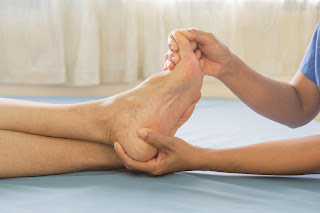There are 2 Cruciate ligaments in the knee. These are the
Anterior Cruciate Ligament (ACL) and Posterior Cruciate Ligament (PCL). The
role of the cruciate ligaments is to provide stability by limiting the amount
of bending, strengthening, and rotation within the knee. Therefore an injury to
this structure can be very debilitating.
The cruciate ligaments are found within the knee joint and
cross each other like an X. The ACL is lateral (outside) and PCL is medial (inside).
The ACL keeps the tibia from slipping forward and PCL from the tibia slipping
backwards.
Causes:
ACL injury:
👣 Mostly occur during sports, especially
collision or contact sports e.g football, or basketball
👣 Landing awkwardly from a jump
👣 Abnormal twisting
👣 Direct blow when foot is firmly planted
in the ground
👣 Awkward fall
👣 Stopping suddenly when running
PCL injury:
👣 Less common injury
👣 PCL can tear if shinbone is hit hard just
below the knee or if you fall on a bent knee
👣 Motor vehicle accident- Dashboard injury
when knee hits the dashboard
👣 Contact sport. Falling on a bent knee or
contact on a bent knee
Symptoms:
ACL:
👣
May feel popping sound
👣 Pain
👣 Knee instability
👣 Unable to weightbear
👣 Swelling
👣 Reduced range of movement
PCL:
👣 Severe knee pain
👣 Swelling
👣 Pain on weightbearing
👣 Unable to straighten knee
👣 May feel/ hear grating, cracking, popping
noises
Treatment:
👣 Follow the POLICE protocol:
Protection- Rest for the first few days following injury ,
however, you should then begin gentle motions to maintain movement and avoid a decreased
muscle strength and flexibility. You may require assistive devices at this time,
for example crutches.
Optimal Loading- Whilst protecting the effected area, gentle
movement should be started to help promote optimal healing of the injury and prevent
delay in returning to normal activities.
Ice- Apply ice to help manage swelling. Ice can also help
decrease some acute pain.
Compression- Compression bandaging will help reduce swelling
as a result of the inflammatory process.
Elevation- Elevating the foot above heart level will help
reduce swelling by allowing fluid to drain from the area.
👣 Avoid the HARM factors for 2-3 days post
injury
Heat- Increases swelling and bleeding. Avoid hot baths, heat
packs and saunas
Alcohol- Can delay healing by increasing swelling and
bleeding
Running or exercise- This can aggravate the injury and
therefore increase pain, swelling and bleeding.
Massage- Massage on the injured area can aggravate the
damaged tissues. Massage away from the injury site may be helpful. Seek medical
advice before proceeding.
👣 Immobilise knee
👣 Seek Medical attention
👣 Rehab program to strengthen the knee







